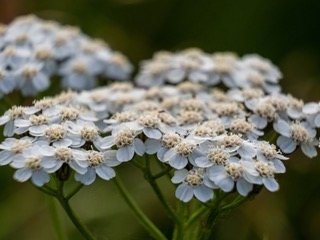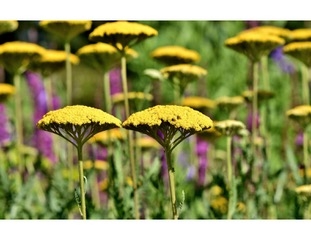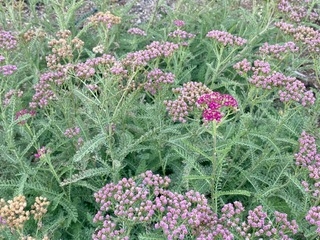Yarrow is a plant that people have used for thousands of years. Indeed, Linnaeus, the father of plant taxonomy, gave yarrow the genus name Achillea after the great Greek warrior Achilles, who supposedly carried common yarrow with his army to treat battle wounds. It goes by many other common names, most of them related to its use on the battlefield: herbe militaris, knight's milfoil, staunchweed and soldier's woundwort (the latter from the US Civil War). Native American nations across the continent used yarrow for everything from toothaches to menstrual cramps. Common yarrow (Achillea millefolium) is found in every California habitat except the Mojave and Colorado Deserts; the Miwok used the plant as an analgesic and head cold remedy. Indeed, it would be hard to find a plant with such a long and varied history of uses, but my objective here is to focus on this often-overlooked plant simply as an ornamental!
Between the soil, the wind and the varmints, I have challenging growing conditions in my yard, to say the least. Yarrow is virtually pest-free—even deer and rabbits avoid it. It's pretty drought tolerant once established, and it prefers sandy, poor to average soil. Indeed, very fertile soil will cause too much top growth, and the leggy stems will flop over. In other words, it's just the plant for me!
Now, your past experience with yarrow may be different. Many yarrows spread by rhizomes, and in well-watered locations they can get out of control. But out here where even weeds don't prosper, I prefer my plants to be a bit aggressive! And if you choose the right yarrow and put it in the right location, you'll earn a lot of garden interest for almost no investment.
There are about 80 species of yarrow worldwide, but nearly all those found in nurseries come from just two of those species: Achillea millefolium and A filipendulina. Nearly everyone is familiar with the tall (2-3') yellow yarrows. ‘Coronation Gold,' ‘Moonshine,' and ‘Cloth of Gold' (my favorite) are three that are widely available. These are Achillea filipendulina hybrids and cultivars, and while they are hard to beat for a spectacular early season display, by July they are looking pretty bedraggled. I harvest many of the stems when they are first opening for dried flowers, and when the remainder start to fade, I cut them back to encourage a second bloom in fall. Best to place these vigorous growers near the back of the bed, because they're a bit drab after this shearing!
But beyond these most commonly seen cultivars, there is a whole world of tough, attractive yarrow to fit most anywhere in the garden. Woolly yarrow (Achillea tomentosa) is grown chiefly for its gray, fuzzy fern-like leaves. This spreader has yellow flowers and stays 6-12” high, the perfect plant for edging stones at the front of your beds. You can sometimes find this among the ground covers at local nurseries. ‘King Edward' (Achillea x lewisii) is similar, with beautiful butter-yellow flowers, but so far I've only been able to find it available one place online. Achillea ptarmica is unique, the flowers borne more singularly than the umbel typical of the genus. Some people use this more sophisticated yarrow as a substitute for baby's breath. Like many of the others listed here, you're not likely to come across plants in a nursery, but all yarrows are easy to grow from seed, so if you can wait a few years, you'll have plenty of flowers down the line.
Easier to find in nurseries, sometimes even in 6-packs, are intermediate-sized yarrows in all shades of pink, rose and cream colors. Most of these are cultivars of Achillea millefolium (common yarrow). I found ‘Paprika,' ‘Red Beauty,' ‘Island Pink' and ‘Summer Pastels' all in local nurseries this past summer, as well as a new dwarf cultivar of ‘Moonshine' and the russet tones of ‘Terra Cotta.' High Country Gardens is one of many places to find plants online, and if you're willing to grow your own, there are even more options available from places like Swallowtail Seeds.
I'm going big on yarrows this year! I planted seeds of ‘Colorado Mix,' ‘Summer Berries,' red, rose and white, and they all sprouted in less than a week, with germination rates of nearly 100%. Between the newcomers and all those I've already planted, I should have carefree blooms throughout the summer. And—since yarrows make great dried flowers—they will brighten the cool season.
Note: Links to sources in this article are provided as a convenience to the reader. No endorsement by UC Regents is implied or intended.


